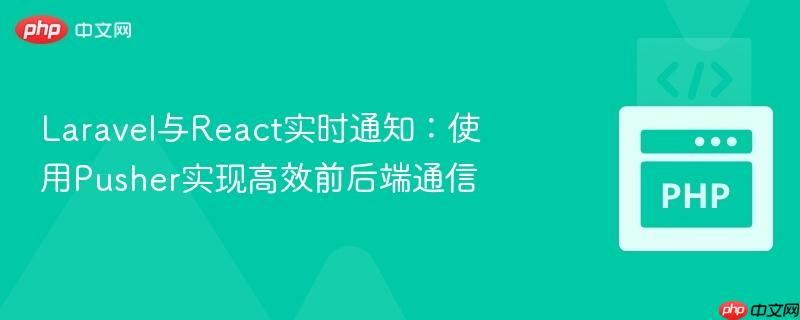
在现代Web应用中,实时通知是提升用户体验的关键功能之一。当后端发生数据更新或特定事件时,前端需要立即收到反馈。直接的HTTP请求-响应模式无法满足这种实时性需求。对于浏览器推送通知(Web Push Notifications),虽然Service Worker的self.addEventListener('push')事件可以监听来自服务器的推送,但它通常需要复杂的VAPID密钥配置、用户授权管理,并且主要用于在浏览器未激活时向用户发送系统级通知。对于应用内部的实时数据更新或通知,采用专门的实时通信库(如Pusher)往往更为高效和灵活。
原始问题中遇到的Unexpected use of 'self' no restricted-globals错误,通常发生在Service Worker脚本中尝试访问非Service Worker全局对象时,或者是在不正确的上下文中使用self。更重要的是,即使解决了这个语法问题,Laravel的Notification::send方法默认情况下并不直接触发Web Push API的push事件,它需要与特定的Web Push通知通道配合使用。对于更通用的实时事件广播,Pusher提供了更简洁的解决方案。
Pusher是一个托管的实时API服务,它允许开发者轻松地将实时功能集成到Web、移动和IoT应用中。它通过WebSocket技术在客户端和服务器之间建立持久连接,实现低延迟的双向通信。Laravel内置了对Pusher的支持,使其成为实现实时事件广播的理想选择。
要在Laravel应用中集成Pusher,你需要完成以下步骤:
首先,通过Composer安装Pusher PHP SDK:
composer require pusher/pusher-php-server
Laravel使用广播(Broadcasting)来发送事件。你需要将广播驱动配置为pusher。 在你的.env文件中,添加Pusher的凭据:
BROADCAST_DRIVER=pusher PUSHER_APP_ID=your-pusher-app-id PUSHER_APP_KEY=your-pusher-app-key PUSHER_APP_SECRET=your-pusher-app-secret PUSHER_APP_CLUSTER=your-pusher-app-cluster # 例如:ap2, mt1, eu
这些凭据可以在Pusher仪表盘中创建和获取。 确保在config/app.php中取消注释App\Providers\BroadcastServiceProvider::class,以便启用广播服务提供者。
创建一个新的事件,并实现ShouldBroadcast接口。这将告诉Laravel该事件应该被广播。
// app/Events/NewNotification.php
<?php
namespace App\Events;
use Illuminate\Broadcasting\Channel;
use Illuminate\Broadcasting\InteractsWithSockets;
use Illuminate\Contracts\Broadcasting\ShouldBroadcast;
use Illuminate\Foundation\Events\Dispatchable;
use Illuminate\Queue\SerializesModels;
class NewNotification implements ShouldBroadcast
{
use Dispatchable, InteractsWithSockets, SerializesModels;
public $message;
public $title;
public $icon;
/**
* Create a new event instance.
*
* @param string $title
* @param string $message
* @param string|null $icon
*/
public function __construct($title, $message, $icon = null)
{
$this->title = $title;
$this->message = $message;
$this->icon = $icon;
}
/**
* Get the channels the event should broadcast on.
*
* @return array<int, \Illuminate\Broadcasting\Channel>
*/
public function broadcastOn(): array
{
// 广播到一个公共频道
return [new Channel('notifyChannel')];
}
/**
* The event's broadcast name.
*
* @return string
*/
public function broadcastAs()
{
return 'notifyEvent'; // 事件的名称,前端将通过这个名称监听
}
}在上面的例子中,broadcastOn()方法定义了事件将广播到的频道(notifyChannel),broadcastAs()方法定义了事件的名称(notifyEvent)。
你可以在任何需要发送通知的地方(例如控制器、服务或模型)触发这个事件。
// app/Http/Controllers/PushController.php
<?php
namespace App\Http\Controllers;
use Illuminate\Http\Request;
use App\Events\NewNotification; // 引入你定义的事件
use Illuminate\Support\Facades\Log;
class PushController extends Controller
{
public function sendNotification(Request $request)
{
// 假设你要发送一个简单的通知
$title = "新消息!";
$message = "您有一个新的订单等待处理。";
$icon = "https://example.com/notification-icon.png";
// 触发事件,Laravel会通过Pusher将其广播
event(new NewNotification($title, $message, $icon));
Log::info('Notification event dispatched.');
return response()->json(['status' => 'Notification sent!']);
}
// ... 你的其他方法,例如store
}当sendNotification方法被调用时,NewNotification事件会被触发并通过Pusher广播到notifyChannel频道。
在React应用中,你需要安装Pusher JavaScript客户端库并监听相应的频道和事件。
npm install --save pusher-js # 或者 yarn add pusher-js
在你的React组件中,使用useEffect钩子来初始化Pusher连接并订阅频道。
// src/components/NotificationListener.js 或你的主要App.js
import React, { useEffect } from 'react';
import Pusher from 'pusher-js';
const NotificationListener = () => {
useEffect(() => {
// 确保在组件挂载时只执行一次
const pusher = new Pusher(process.env.REACT_APP_PUSHER_APP_KEY, {
cluster: process.env.REACT_APP_PUSHER_APP_CLUSTER,
encrypted: true, // 建议使用加密连接
});
const channel = pusher.subscribe('notifyChannel'); // 订阅与Laravel中定义的频道相同的频道
// 绑定到Laravel中定义的事件名称
channel.bind('notifyEvent', function (data) {
console.log('收到实时通知:', data);
// 在这里处理收到的通知数据
// 例如,显示一个浏览器通知,或者更新UI
alert(`新通知: ${data.title} - ${data.message}`);
// 如果需要显示Web Push API风格的浏览器通知,可以在这里调用
if (Notification.permission === 'granted') {
navigator.serviceWorker.ready.then(registration => {
registration.showNotification(data.title, {
body: data.message,
icon: data.icon,
// actions: data.actions // 如果需要,可以添加通知操作
});
});
}
});
// 清理函数:在组件卸载时取消订阅
return () => {
pusher.unsubscribe('notifyChannel');
pusher.disconnect();
};
}, []); // 空数组表示只在组件挂载和卸载时执行
return (
<div>
{/* 你的React应用的其他内容 */}
<p>正在监听实时通知...</p>
</div>
);
};
export default NotificationListener;注意事项:
REACT_APP_PUSHER_APP_KEY=your-pusher-app-key REACT_APP_PUSHER_APP_CLUSTER=your-pusher-app-cluster
请确保这些环境变量以REACT_APP_开头,以便Create React App能够正确识别它们。
原始问题中的Laravel代码片段使用了Notification::send($users, new PushDemo),这通常与Laravel的通知系统结合使用。如果PushDemo通知类配置了WebPushChannel,它确实可以用于发送Web Push通知。同时,React中的self.addEventListener('push')是Service Worker用于监听Web Push API事件的标准方式。
然而,Pusher提供的实时广播机制与Web Push API是不同的。
因此,当你希望在React应用内部实现实时的事件驱动更新时,Pusher是一个更直接、更易于管理的解决方案。如果你仍然需要实现系统级的浏览器推送通知,那么你需要同时配置Laravel的Web Push通知通道,并确保Service Worker正确注册和监听push事件。但对于大多数应用内部的实时通知场景,Pusher的实时广播功能已足够。
通过Pusher,Laravel和React应用可以轻松实现强大的实时通知功能。Laravel负责事件的广播,而React负责订阅和展示这些事件。这种方法不仅解决了传统Service Worker在特定场景下的限制,还提供了一个健壮、可扩展的实时通信架构,极大地提升了用户体验。理解Web Push API与Pusher实时广播的区别,将帮助你选择最适合你应用场景的解决方案。
以上就是Laravel与React实时通知:使用Pusher实现高效前后端通信的详细内容,更多请关注php中文网其它相关文章!

每个人都需要一台速度更快、更稳定的 PC。随着时间的推移,垃圾文件、旧注册表数据和不必要的后台进程会占用资源并降低性能。幸运的是,许多工具可以让 Windows 保持平稳运行。

Copyright 2014-2025 https://www.php.cn/ All Rights Reserved | php.cn | 湘ICP备2023035733号